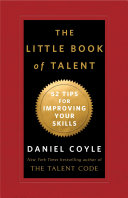

Deliberate practice is a focused and purposeful way of improving skills. It involves setting specific goals, receiving immediate feedback, and making adjustments based on that feedback. The author emphasizes that mere repetition of tasks does not lead to improvement; instead, it is the quality of practice that counts. This idea is rooted in the notion that talent is not innate but developed through dedicated effort. By engaging in deliberate practice, individuals can break down complex skills into manageable parts, allowing for gradual improvement. The book provides insights into how to structure practice sessions effectively, ensuring that each session is targeted towards enhancing specific aspects of performance.
Continue readingFeedback is a critical component of the learning process. The book highlights how immediate and constructive feedback can accelerate skill acquisition. The author argues that without feedback, individuals may continue to practice incorrectly, reinforcing bad habits. The text provides examples of how successful individuals seek out feedback from coaches, mentors, or peers to refine their skills. It emphasizes that feedback should be specific and actionable, allowing individuals to understand what they need to improve. The book also discusses the psychological aspects of receiving feedback, including how to handle criticism and use it as a tool for growth.
Continue readingVisualization is a technique used by many top performers to enhance their skills. The book explains how visualizing successful performance can prepare the brain for actual execution. This mental rehearsal helps individuals to create a mental blueprint of what they want to achieve, which can lead to improved performance. The author discusses various visualization techniques and how they can be incorporated into practice routines. By imagining themselves succeeding, individuals can increase their confidence and reduce anxiety. The text also touches on the science behind visualization, explaining how it activates similar brain regions as actual practice, thereby reinforcing the neural pathways associated with the skill.
Continue readingHaving mentors and role models can significantly impact an individual's skill development. The book discusses how observing and learning from those who have already achieved success can provide valuable insights and inspiration. The author encourages readers to seek out mentors who can guide them, offer feedback, and share their experiences. The text also emphasizes the importance of surrounding oneself with a supportive community that fosters growth. By learning from the successes and failures of others, individuals can avoid common pitfalls and accelerate their own journey towards mastery.
Continue readingGrit, defined as passion and perseverance for long-term goals, is a key theme in the book. The author argues that talent alone is not enough; it is the ability to persist through challenges and setbacks that ultimately leads to success. The text provides examples of individuals who have achieved greatness through sheer determination and hard work. The book encourages readers to cultivate a growth mindset, viewing challenges as opportunities for learning rather than obstacles. It highlights the importance of resilience and the ability to bounce back from failures as essential traits for anyone seeking to develop their talents.
Continue readingThe environment in which one practices can greatly influence skill development. The book discusses how to create a conducive environment that fosters growth, including minimizing distractions and setting up routines that promote focused practice. The author emphasizes the importance of having the right tools and resources at one's disposal to facilitate learning. Additionally, the text explores how social environments, such as being part of a team or community, can provide motivation and support, enhancing the overall learning experience. By creating an optimal environment, individuals can maximize their potential for skill acquisition.
Continue readingFailure is often viewed negatively, but the book reframes it as a crucial part of the learning process. The author argues that embracing failure can lead to greater insights and improvements. The text encourages readers to analyze their failures critically, extracting lessons that can inform future practice. By shifting the perspective on failure, individuals can reduce fear and anxiety associated with performing, allowing them to take risks and experiment with new approaches. The book provides strategies for reflecting on failures and using them as stepping stones towards success.
Continue reading